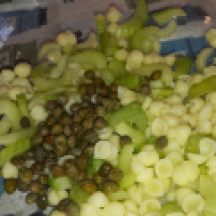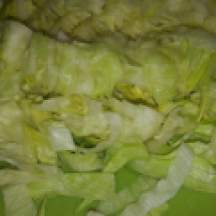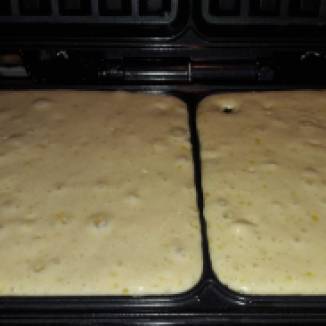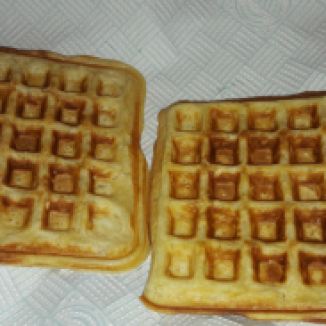On a super, short holiday in Gdańsk just before Easter, I had several delicious breakfasts in a restaurant in the Old Town called Gvara- the name is based on the Polish word gwara which means dialect (Polish does not have the letter v !).
Two of the breakfasts were waffles served with savoury toppings. First with smoked bacon and eggs and then with fried onions, red peppers and spinach – topped with a poached egg – I was converted!
On my return I had to recreate these lovely dishes!
On previous visits to Poland I have always been surprised to see how popular waffles (gofry in Polish – from the French – gaufres) are.
These waffles, which are often sold on street stalls or at fairs are usually sweet with the addition of sugar and jams etc.
A Short History of Waffles
In ancient times the Greeks cooked flat cakes, called obelios, between hot metal plates.
Over time they became popular throughout medieval Europe, the cake mix, a mixture of flour, water or milk, and often eggs, were also cooked over an open fire between iron plates with long handles.
Paintings from the 16th century by Joachim de Beuckelaer, Pieter Aertsen and Pieter Bruegel show waffles being cooked.
The word waffle first appears in the English language in the 18th Century – it comes from the Dutch wafel & Middle Dutch wafele – the word for a wafer.
Originally they were made without a raising agent.
Nowadays waffles are made from a batter with yeast or baking powder (invented by the English chemist Alfred Bird in 1843)and are cooked between two patterned plates.
In some versions, the waffles are thin and more crispy – more biscuit like.
Early waffles were unsweetened or sweetened with honey and sugar-sweetened waffles were expensive.
By the 18th century, the expansion of Caribbean plantations had cut sugar prices in half and recipes abounded with much use of sugar.
Making Waffles
I bought an electric waffle maker, which makes thick waffles. It is by Salter and I am very pleased with it.
Baking Powder Waffles
This recipe is based on the one in the recipe book that comes with waffle maker.
I used whole milk and found this worked very well.
Other recipes I looked at used buttermilk, so I tried this with a yoghurt & milk mixture – they tasted okay but the mixture escaped out of the maker quite a bit – so there was a lot to clean up.
Ingredients
- 250g plain flour
- 2 tablespoons of granulated sugar
- 4 teaspoons of baking powder
- 1/2 teaspoon of salt
- 2 egg
- 90g of butter
- 350ml of whole milk
Method
This amount made eight waffles in my maker.
It is best to make all the waffles at once and either keep them warm in a low oven or you can pop then in a toaster later.
- Mix the flour, salt, sugar and baking powder together in a bowl.
- Melt the butter.
- Beat the eggs until they are fluffy.
- Add the eggs and then the milk to the flour mixture and mix well.
- Add the melted butter to the mixture and mix well.
- I made the waffles as per the instructions of the waffle maker.
- Pre-heat the maker for around 5 minutes.
- Brush some oil or butter onto the plates for the first batch.
- Use a ladle to pour on the mixture – filling the plate till around 3/4 full.
- Cook for around 5 minutes – all steam should have finished being given off by now.
Yeast Waffles
The batter is left to rise overnight.
Ingredients
- 100g butter
- 400ml milk (whole or semi-skimmed)
- 360g plain flour
- 1 tablespoon granulated sugar or honey
- 1 tablespoon salt
- 1 tablespoon dry yeast
- 1 teaspoon salt
- 2 eggs
Method
This amount made around eight waffles in my maker.
You can make all the waffles at once and either keep them warm in a low oven or you can pop then in a toaster – with this yeast batter you can stagger the timing a little if you do not want to make them all at once.
- In a saucepan melt the butter.
- Add the milk and heat up the mixture.
- Leave to cool to hand heat.
- In a bowl mix the flour, sugar (or honey), yeast and salt.
- Whisk the eggs till frothy.
- Add the eggs to flour mixture.
- Add the cooled butter/milk mixture.
- Cover the bowl with cling film and leave in the fridge overnight.
- As above, I made the waffles as per the instructions of the waffle maker.
- Pre-heat the maker for around 5 minutes.
- Brush some oil or butter onto the plates for the first batch.
- Use a ladle to pour on the mixture – filling the plate till around 3/4 full.
- Cook for around 5 minutes – all steam should have finished being given off by now.
Toppings for the Waffles
Bacon & Eggs
- Grill or pan fry, without oil, some smoked bacon rashers.
- Soft fry or poach eggs.
- Pour some maple syrup on the waffles
- Place some rashers of bacon on the waffles
- Top with the egg.
Fried onions, red peppers, spinach & egg
Ingredients
- Onion – around 1/2 per waffle
- Red pepper – around 1/2 per waffle
- Fresh spinach – a large handful per waffle
- 2-3 tablespoons of butter – depending on how much you are making.
- Salt & ground black pepper to serve.
Method
- Slice the peppers into long strips
- Blanch the peppers with boiling water and leave for at least 15 minutes.
- Use a deep frying pan with a lid (a glass one is best).
- Melt the butter in the pan on a gently heat.
- Slice the onions into strips and fry gently in the butter till soft and golden.
- Dry the peppers and add these to the onions and cook gently with the lid on for some of the time.
- Put the spinach on top, put on the lid and allow it to cook in the steam.
- Take off the lid, stir and cook off excess liquid.
- Place some onions, peppers and spinach a waffle.
- Season with salt & ground black pepper
- Top with a soft fried or poached egg.


























































































